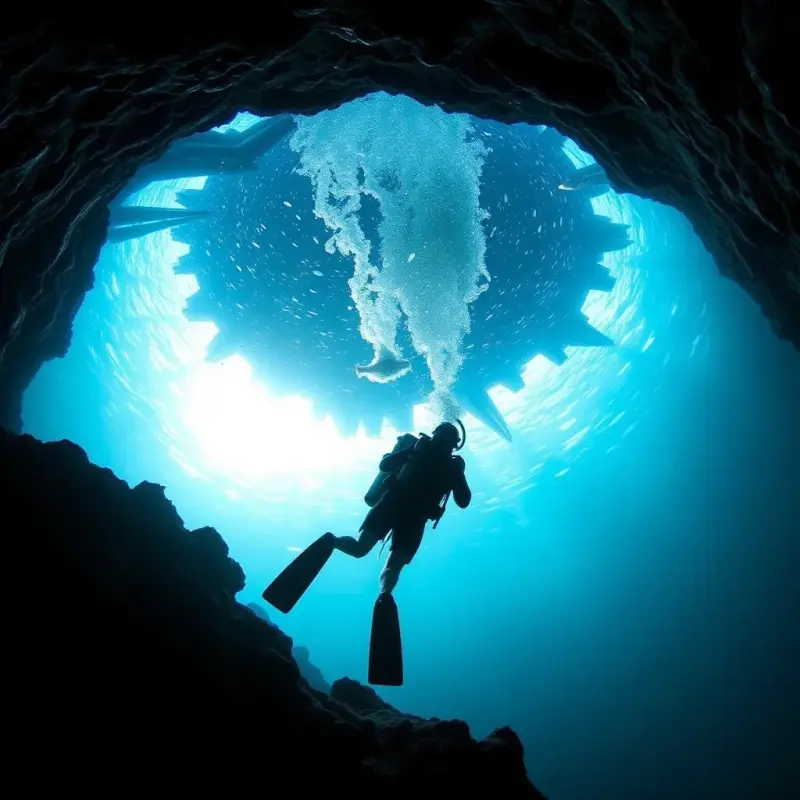Essential Gadgets for Exploring Underwater Caves: How Technology Enhances Safe Deep Dives
Underwater caves, with their mysterious pathways and fragile ecosystems, present some of the most challenging environments for exploration. For divers, they offer the allure of discovery mixed with the potential hazards of deep, dark, and narrow spaces. However, thanks to advancements in underwater exploration technology, enthusiasts and scientists alike can explore these unique environments with enhanced safety and precision. This article will explore the essential gadgets that have transformed the field of underwater cave diving, focusing on innovations that help divers reach deeper, navigate complex cave systems, and ensure safe, monitored dives.

1. Advanced Diving Computers: Precision and Control
Diving computers are among the most critical tools for any diver venturing into underwater caves. These devices provide essential real-time data about depth, time, and decompression stops, which are vital in managing dive duration and oxygen consumption. With specific features for technical diving, modern diving computers allow users to monitor multiple gas mixtures and set alarms for specific depths or times.
For cave divers, the adaptability of diving computers to various diving gases, such as nitrox and trimix, is invaluable. The latest models feature color screens with intuitive interfaces, GPS tracking for surface positioning, and high-sensitivity pressure sensors that help divers make rapid adjustments based on their depth and gas levels.
2. Underwater Drones: Mapping and Exploration
In situations where human divers cannot safely proceed due to narrow or dangerous passages, underwater drones, or ROVs (Remotely Operated Vehicles), step in to explore on their behalf. These drones are compact, maneuverable, and equipped with powerful lights and high-resolution cameras, allowing divers to visualize challenging areas remotely.
Equipped with sonar mapping technology, underwater drones generate precise topographic maps of underwater cave networks. These maps not only help divers plan their routes but also play a crucial role in monitoring cave environments and documenting changes over time.
3. High-Luminosity LED Dive Lights: Visibility in the Dark
The natural darkness of underwater caves necessitates powerful and reliable lighting. Standard dive lights don’t suffice for this level of exploration, which is why high-luminosity LED dive lights are essential. LED lights are known for their efficiency, long battery life, and brightness. Many high-end dive lights also feature adjustable light settings, allowing divers to conserve battery power when a softer light is sufficient and switch to a powerful beam for navigation or signaling.
Additionally, some advanced models are specifically designed for the limited visibility of cave diving, offering narrow beam widths to cut through particles in the water without disturbing the surrounding environment.
4. Rebreathers: Extending Dive Duration
Unlike traditional scuba tanks, rebreathers recycle a diver’s exhaled air by removing carbon dioxide and adding oxygen. This allows for a more extended dive duration and reduces the formation of bubbles, which can disrupt delicate cave environments. With electronic sensors that monitor oxygen levels continuously, rebreathers offer precise control over gas mixtures, especially useful for deep dives that require different gases.
Modern rebreathers are compact, lightweight, and increasingly user-friendly, making them suitable for both professional cave divers and serious enthusiasts. By using rebreathers, divers are better equipped to manage the prolonged dive times necessary for thorough cave exploration.
5. Communication Devices: Real-Time Contact with the Surface
Communication with a surface team is critical for any diver exploring underwater caves. Modern underwater communication devices allow divers to stay in contact with team members both underwater and on the surface. These devices use acoustic waves to transmit voice messages, which are translated into audible sound through headsets.
While traditional radio communication is ineffective underwater, acoustic systems provide reliable communication even in challenging conditions. This setup is vital in case of emergencies or when divers need to coordinate their movements across complex cave systems.
6. Environment Monitoring Sensors: Ensuring Safe Conditions
In underwater caves, conditions can change rapidly, and divers need to monitor environmental factors like temperature, visibility, and water flow. Environment-monitoring sensors are compact, portable devices that can measure these variables in real time.
Advanced sensors can detect subtle changes in water current or temperature, helping divers understand the risks of confined areas or unstable passages. They also support scientific research, enabling data collection on water quality, species populations, and ecological changes within caves.
7. Compact Buoyancy Control Devices (BCDs): Precision in Narrow Spaces
Buoyancy control is crucial in underwater cave exploration, where even minor movements can displace sediment and reduce visibility. Compact BCDs, designed specifically for technical and cave diving, offer enhanced buoyancy control in confined spaces. These devices have a streamlined design, which reduces drag and makes maneuvering in tight areas more manageable.
Modern BCDs allow divers to make precise adjustments to their buoyancy with advanced airflow systems, ensuring smooth ascents and descents in complex cave passages. This precision not only conserves energy but also prevents accidents caused by uncontrolled buoyancy shifts.
8. Backup Gadgets and Redundancy Systems: Safety First
When it comes to cave diving, having redundant systems is a fundamental safety principle. Redundant air sources, backup lights, extra diving computers, and emergency location beacons are all essential. These backups provide layers of security, giving divers the resources to handle unexpected situations.
One of the most critical pieces of backup gear is the emergency ascent reel, a tool that allows divers to guide themselves out of complex cave systems in low-visibility situations. Paired with a compass and backup lights, these tools ensure that divers can navigate safely even if their primary equipment fails.
Conclusion
Exploring underwater caves is a remarkable yet demanding endeavor. The blend of advanced diving technology and careful preparation allows divers to push their boundaries while minimizing risk. With equipment designed to provide real-time data, visual mapping, environmental awareness, and reliable communication, divers can explore deeper and more intricate cave networks. As technology continues to evolve, we can expect even more groundbreaking innovations, enabling safe exploration of some of Earth’s most mysterious underwater environments.
Articles
Register for our notifications and have the newest and most intriguing articles sent directly to your email.